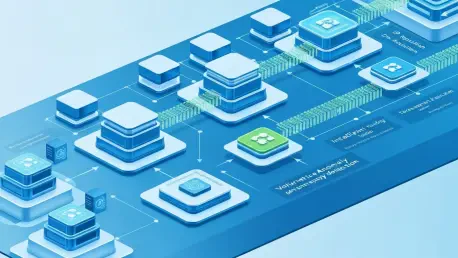In a striking demonstration of the escalating dangers in the cybersecurity realm, Microsoft Azure, a cornerstone of cloud computing, encountered an extraordinary challenge on October 24, 2025, when it faced a distributed denial-of-service (DDoS) attack peaking at an unprecedented 15.72 terabits per second (Tbps). This assault, orchestrated by the Aisuru botnet—a network of compromised Internet of Things (IoT) devices—set a new benchmark for cyber threats, revealing the devastating potential of everyday technology turned into weapons. With nearly 3.64 billion packets per second bombarding a single public IP address in Australia, the attack was a brute-force effort to cripple the system. Yet, Azure emerged unscathed, thanks to its robust global mitigation infrastructure that seamlessly managed the deluge. This incident not only underscores the growing menace of IoT-driven botnets but also prompts critical questions about the future of digital defense as attack scales continue to soar. The resilience displayed by Azure offers a glimmer of hope, yet the audacity and sophistication of such threats signal an urgent need for deeper scrutiny into how these attacks are mounted and countered.
Unpacking the Attack and Azure’s Robust Defense
Dissecting the Magnitude and Method of the Onslaught
The sheer scale of the 15.72 Tbps DDoS attack on Azure was staggering, targeting a solitary public IP address hosted in Australia with over 500,000 unique source IP addresses contributing to the chaos. This volumetric assault relied heavily on high-rate User Datagram Protocol (UDP) floods, employing minimal source-address spoofing and randomized source ports to maximize impact. Unlike more deceptive attacks that mask their origins, this was a direct and unrelenting attempt to overwhelm the endpoint through sheer volume. The mechanics of the attack revealed a calculated strategy to push infrastructure to its limits, testing the boundaries of even the most advanced cloud platforms. Such an approach, while seemingly straightforward, posed a significant challenge due to the raw power behind it, drawing attention to the evolving tactics of modern cybercriminals who wield vast networks of compromised devices.
Beyond the numbers, the attack’s execution highlighted a critical shift in DDoS methodologies, where brute force often trumps subtlety in the quest to disrupt services. The involvement of real, traceable IP addresses offered a potential avenue for defenders to track and mitigate, yet the sheer quantity of sources complicated immediate response efforts. This incident served as a stark reminder that even single endpoints can become focal points for massive campaigns, necessitating defenses that are not just reactive but also predictive in nature. Azure’s ability to withstand this onslaught without visible disruption to customer workloads pointed to the effectiveness of automated systems, yet it also raised concerns about the resources required to fend off future attacks of similar or greater magnitude. The balance between attack scale and defensive capability remains a pivotal concern for cloud providers navigating this hostile digital landscape.
Strength and Adaptability of Cloud Defenses
Azure’s response to this unprecedented attack showcased the formidable strength of modern cloud infrastructure, designed to absorb and neutralize multi-terabit threats with minimal impact. The platform’s global DDoS mitigation system activated instantly, routing the enormous traffic influx through distributed networks, filtering out malicious packets, and suppressing the attack before it could affect users. This seamless operation reflected years of investment in scalable architectures that prioritize redundancy and resilience, ensuring that even under extreme pressure, service continuity is maintained. Such capabilities are essential in an era where cyber threats are not just frequent but also increasingly voluminous, pushing the boundaries of what technology can endure.
However, while Azure’s defense mechanisms proved effective, the incident also illuminated potential vulnerabilities in the long-term sustainability of such systems as botnet capabilities evolve at a rapid pace. Each successful mitigation, though a victory, consumes significant computational and financial resources, raising questions about scalability when attacks surpass current thresholds. The cybersecurity community must consider whether relying solely on absorption and filtering will suffice as adversaries harness more powerful tools. This event emphasized the need for proactive measures, such as enhanced threat intelligence and preemptive network hardening, to complement reactive defenses. As attack magnitudes grow, cloud providers like Azure face the dual challenge of maintaining robust protections while innovating to stay ahead of an ever-adapting threat landscape.
The Aisuru Botnet: A Formidable Cyber Adversary
Advanced Technical Framework and Continuous Evolution
The Aisuru botnet, classified as a “Turbo Mirai-class” threat, stands out as a chilling evolution of the infamous Mirai malware, boasting enhanced bandwidth and packet throughput that redefine the scale of DDoS attacks. Its technical sophistication lies in a custom communication protocol fortified by encryption methods like ChaCha20 and HMAC verification, which shield its command-and-control (C2) infrastructure from interception or analysis. This setup, globally distributed across numerous IP addresses and autonomous systems, ensures operational resilience, making it exceedingly difficult for defenders to dismantle. Aisuru’s ability to orchestrate attacks with such precision and power highlights a dangerous leap forward in cybercriminal capabilities, posing a persistent challenge to even the most fortified digital environments.
Equally concerning is Aisuru’s capacity for continuous evolution, demonstrated through malware variants such as Kitty and AIRASHI that adapt to counter mitigation strategies employed by security teams. These updates reflect active development by botnet operators who monitor defensive trends and adjust accordingly, ensuring their network remains a step ahead. The boldness of naming domains associated with C2 servers in ways that taunt researchers further underscores the confidence and audacity behind this threat. As Aisuru evolves, it forces the cybersecurity community to rethink traditional approaches to botnet takedowns, emphasizing the need for dynamic, intelligence-driven responses. The ongoing arms race between attackers and defenders is nowhere more evident than in the relentless innovation displayed by this formidable adversary.
Mechanisms of Device Recruitment and Network Expansion
Aisuru’s strength is deeply rooted in its ability to recruit vast numbers of IoT devices, transforming mundane consumer products like home routers, IP cameras, and digital video recorders into tools of disruption. By exploiting known vulnerabilities, zero-day flaws, and weak or default credentials, the botnet rapidly expands its reach, often adding tens of thousands of devices in a single event. A notable spike occurred through the compromise of a TotoLink firmware update server, which alone contributed approximately 100,000 new bots to its arsenal. This systematic approach to infection and integration reveals a well-structured operation designed to maximize firepower with minimal effort, capitalizing on the widespread neglect of basic security practices among device owners and manufacturers alike.
The global distribution of Aisuru’s infected nodes across multiple internet service providers (ISPs) and countries adds another layer of complexity to mitigation efforts, as localized disruptions or takedowns have limited impact on its overall network. Once compromised, devices connect to C2 servers to receive commands for launching DDoS attacks or enabling proxy services, while also transmitting telemetry data for optimization. This workflow ensures that the botnet remains agile and adaptable, capable of scaling its operations as new vulnerabilities emerge. The ease with which Aisuru propagates underscores a critical gap in IoT security, where the proliferation of connected devices far outpaces the implementation of robust safeguards, leaving a fertile ground for exploitation by sophisticated threats.
Escalating Threats and Wider Implications
Rising Frequency and Intensity of Attack Campaigns
The attack on Azure was not an isolated incident but part of a broader pattern of escalating campaigns attributed to Aisuru, each demonstrating a terrifying increase in scale and impact. Prior to the 15.72 Tbps assault, security reports documented an 11.5 Tbps attack in September 2025, followed by outbound traffic surges peaking at 29.6 Tbps as recorded by U.S.-based ISPs in October. These figures illustrate a relentless upward trajectory in the botnet’s destructive potential, surpassing thresholds once considered extreme. Such frequent and intense attacks signal a growing risk not only to individual targets but also to the broader internet ecosystem, where the cumulative effect of these assaults can destabilize critical infrastructure on a massive scale.
Beyond mere volume, Aisuru-class botnets pose a unique threat by pushing network hardware to its physical limits, with some incidents causing line-card failures in ISP equipment. This introduces a new dimension of vulnerability, where infrastructure is not just overwhelmed by traffic but also suffers tangible damage, leading to prolonged outages and costly repairs. Network operators now face the dual challenge of managing digital overloads and safeguarding physical components against stress-induced failures. The escalating magnitude of these campaigns serves as a grim warning that traditional capacity planning may no longer suffice, urging a reevaluation of how resilience is built into the very fabric of internet infrastructure to withstand such unprecedented pressures.
Cybercrime Business Models and Strategic Shifts
Aisuru operates with a chilling level of business acumen, functioning as a DDoS-for-hire platform that offers its vast infrastructure to a select clientele for launching large-scale attacks. This selective targeting, often avoiding governmental or military entities, suggests a calculated strategy to minimize scrutiny from law enforcement while maximizing impact on chosen victims. Such discretion reflects an intent to maintain operational longevity, ensuring the botnet remains a viable tool for hire over extended periods. This model transforms raw cyber power into a marketable commodity, highlighting the commercialization of digital threats and the profitability that drives their persistence in the underground economy.
More recently, Aisuru has diversified its revenue streams by introducing “residential proxy” services, allowing clients to route internet traffic through infected IoT devices with seemingly legitimate residential IP addresses. This pivot indicates a strategic shift toward more sustainable, recurring income compared to the one-off nature of DDoS attacks, blending high-profile disruption with discreet monetization. The adaptability of this dual approach points to a future where access to powerful attack infrastructure becomes increasingly democratized among malicious actors. As cybercrime evolves into a service-oriented industry, the broader implications for cybersecurity include a proliferation of threats that are not only technically sophisticated but also economically incentivized to persist and expand.
Addressing Challenges and Building Stronger Defenses
Persistent IoT Weaknesses and Systemic Vulnerabilities
The root cause of threats like Aisuru lies in the persistent insecurity of IoT devices, which continue to serve as easy entry points for botnet recruitment due to unpatched vulnerabilities and weak credentials. Consumer-grade products, often neglected in terms of software updates or basic password hygiene, become unwitting participants in multi-terabit attacks, amplifying the reach of malicious networks. Manufacturers frequently prioritize functionality and cost over security, leaving devices exposed to exploitation through known flaws or zero-day vulnerabilities. This systemic oversight creates a vast pool of potential bots, readily available for cybercriminals to harness, and underscores a fundamental disconnect between the rapid proliferation of connected technology and the safeguards needed to protect it.
Compounding this issue is the dual nature of the threat posed by infected devices, which not only launch inbound attacks on targets like Azure but also generate outbound risks within ISP networks, degrading service for other customers and straining infrastructure. The ripple effects of such vulnerabilities extend beyond individual users to impact entire ecosystems, where a single compromised device can contribute to widespread disruption. Addressing this challenge requires a paradigm shift in how IoT security is approached, moving beyond reactive patches to proactive design principles that embed robust protections from the outset. Until manufacturers and consumers alike prioritize device security, the foundation of botnets like Aisuru will remain intact, fueling an endless cycle of exploitation and attack.
Collaborative Mitigation and Forward-Looking Strategies
Mitigating the threat of Aisuru and similar botnets demands more than just absorbing traffic; it necessitates a multifaceted approach that includes traceback of real IP sources, rapid device remediation, and network-edge filtering. The traceability of Aisuru’s direct-path traffic presents a rare opportunity for defenders to identify and isolate infected devices, provided they act swiftly in coordination with ISPs. Intelligence sharing across cloud providers, security firms, and network operators is critical to map C2 domains, track propagation patterns, and execute sinkholing efforts that disrupt botnet operations. Such collaboration can transform isolated defenses into a unified front, capable of addressing threats at scale before they escalate into full-blown crises.
Looking ahead, emerging trends like the expansion of botnet-as-a-service models and the physical stress on network hardware signal an intensifying threat landscape that requires innovative responses. Regulatory frameworks may soon demand stricter security standards for IoT manufacturers, enforcing baseline protections to mitigate systemic risks. Meanwhile, enterprises must invest in large-scale scrubbing, edge detection, and distributed mitigation to handle the speed and volume of modern attacks. For consumers, education on patch management and credential hygiene remains foundational to reducing recruitment into botnets. As the digital battleground evolves, a proactive, multilayered strategy—spanning technology, policy, and awareness—offers the best path forward to safeguard against the next wave of IoT-driven cyber assaults, ensuring resilience in an increasingly hostile environment.









